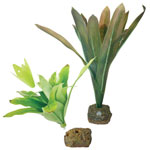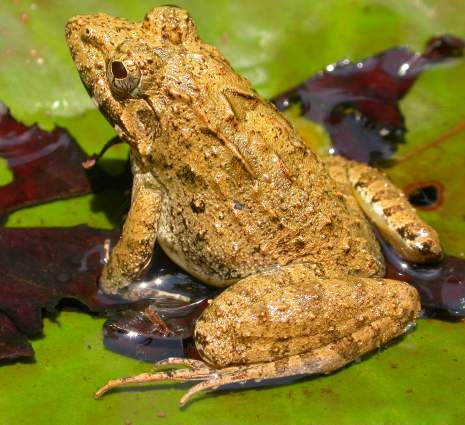From tiny “living jewels” to hulking giants capable of consuming bats, snakes and rodents, the world’s nearly 6,000 frog species present an amazing array of pet-keeping opportunities. With proper care, some may live for decades (to age 50 in the case of the African Bullfrog), and quite a few are active by day and quickly learn to accept food from one’s hand. However, keeping frogs and toads as pets means providing a habitat that meets their specific needs – humidity, temperature, substrate, terrarium size and shape, light, water quality and other conditions must be carefully considered.
Although each has needs that vary from those of others, some general rules have emerged. The following information is drawn from my experiences with hundreds of species over a lifetime of frog-keeping in zoos and at home. It can be applied to most of those that you are likely to encounter. However, details will vary – please post below for information concerning individual species.
Housing
Please remember that your frog’s natural history will dictate the type of terrarium it requires…please post below to discuss the need of individual species, or to share your observations.
Setting up the Terrarium
Active, sedentary, high-strung, aquatic, arboreal and terrestrial frogs and toads utilize their living spaces in different ways. Following are some basic guidelines for popular species.
The tiny, highly-active Poison Frogs (Dendrobates spp.) and Mantellas do best in terrariums stocked with live mosses, ferns and other plants. “Smart Plants” artificial bromeliads, which are equipped with tiny “ponds” in which frogs can deposit their eggs or tadpoles, are very useful (please see photo).
An easily-cleaned, bare-bottomed tank, tilted on one side to create a water section, is ideal for African Bullfrogs, Horned Frogs and other giants that require frequent water changes and are untroubled by a lack of “decorations”.
An aquarium half-filled with water and provisioned with a turtle basking platform and a submersible filter will suit Fire-Bellied Toads, American Green Frogs and other semi-aquatic species.
 African Clawed Frogs, Dwarf Clawed Frogs and Surinam Toads do not need a land area, but do best in tanks stocked with live or plastic plants upon which they can rest.
African Clawed Frogs, Dwarf Clawed Frogs and Surinam Toads do not need a land area, but do best in tanks stocked with live or plastic plants upon which they can rest.
Terrariums for Marine Toads, American Toads, Smoky Jungle Frogs and other terrestrial species should have large land areas and a water bowl. While many individuals will accept commercial caves and hiding spots, most prefer to dig into the substrate when seeking security.
“Hi-style” aquariums with sturdy live or artificial plants, driftwood, vines and branches make ideal homes for White’s Treefrogs, Asian Flying Frogs and similar arboreal species.
Substrate
Sphagnum and carpet moss works well for Poison Frogs and other forest-dwellers, while bare-bottomed terrariums are usually best for African Bullfrogs.
Smooth-Sided Toads, Oak Toads and others with similar lifestyles should be supplied with a mix of potting soil and coconut husk, or a substrate designed for burrowing amphibians.
Frogs often swallow substrate with their meals, and may incur intestinal blockages. In general, gravel should be avoided; if used at all, select a size that is too large to be swallowed. Take care with this…I’ve witnessed autopsies at the Bronx Zoo during which amazingly large stones were removed from frogs’ stomachs. River rock (large black stones sold in garden supply stores) may be a useful option.
Light
Frogs and toads seem not to require UVB radiation, although there is some evidence that low levels may benefit Poison Frogs, Mantellas, and perhaps others that are active by day, dusk, and dawn. For these, the Zoo Med 2.0 UVB Bulb is ideal. UVA radiation may help to encourage natural behaviors and activity cycles. Be sure to provide places where your frogs can avoid direct light.
Heat
Temperatures for tropical species should range from 75-82 F. Frogs from temperate regions fare best at 65-74 F. A cool retreat must always be available. Some fine-tuning is often necessary in this critical area….please post below for detailed information.
A fluorescent bulb may provide enough heat – if not, try a small incandescent bulb or a ceramic heater; all can dry out the substrate, so monitor conditions carefully.
Humidity
Humidity needs vary, but even Colorado River Toads and other desert-dwellers require daily misting, and all should have access to an easily-exited water bowl.
Small humidifiers and humidity gauges specifically designed for use with amphibians and reptiles are very useful, especially for delicate species kept in dry regions.
Water Quality
Porous skins allow frogs and toads to absorb ammonia (released with their waste products) and other harmful chemicals. Ammonia is extremely lethal; an aquarium test kit should be used to monitor its levels.
Most aquatic species are best kept at a pH of 6.5 to 7.5; a simple test kit should be on hand.
Chlorine and chloramine must be removed from water used in aquariums, misting bottles and water bowls. Liquid preparations that render water instantly safe should always be used.
An Important Note on Feeding
A highly-varied diet is essential. Crickets alone, even if powdered with supplements, are not an adequate diet for any species. Please see this article, and those linked below, for further information on this important topic.
Further Reading
 That Reptile Blog – Reptile, Amphibian and Exotic Pet Care and Information
That Reptile Blog – Reptile, Amphibian and Exotic Pet Care and Information




